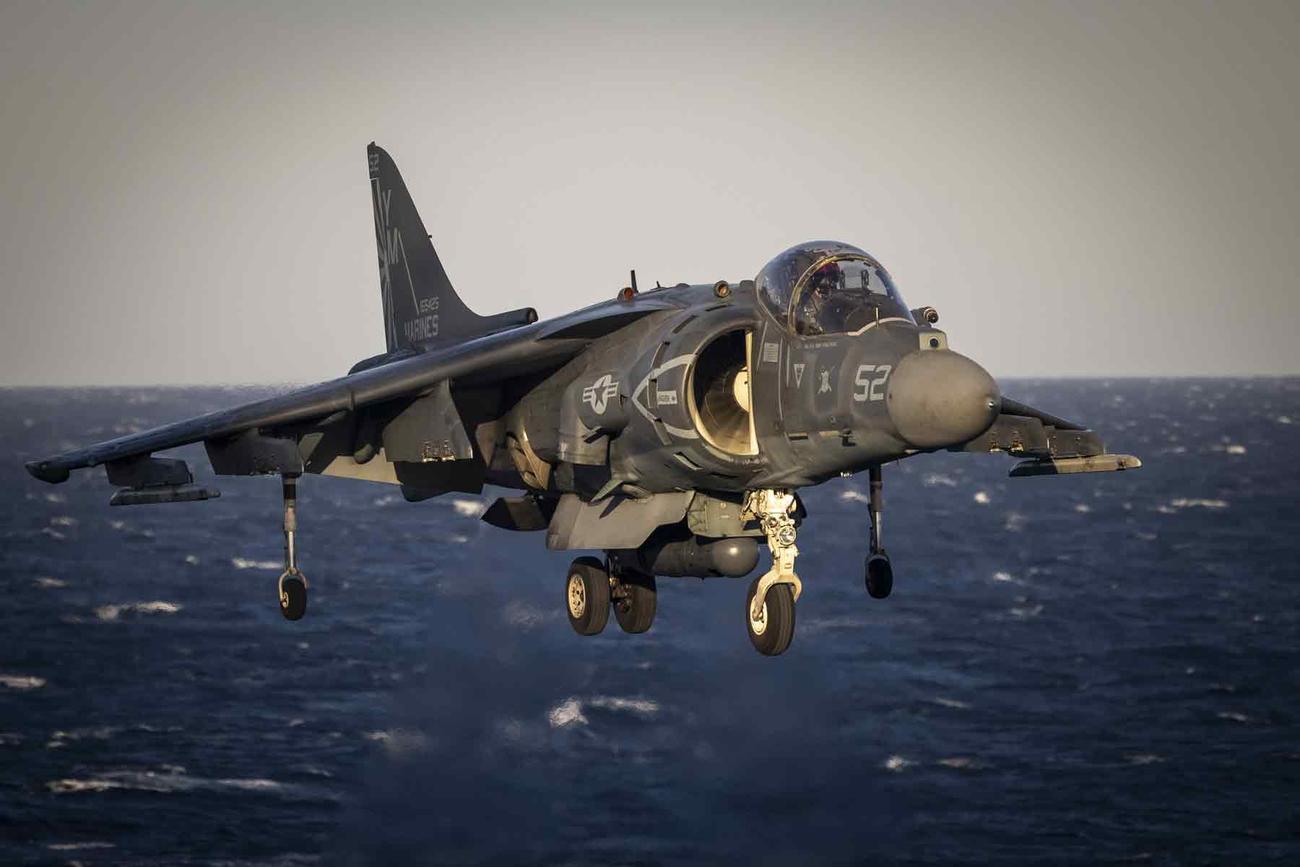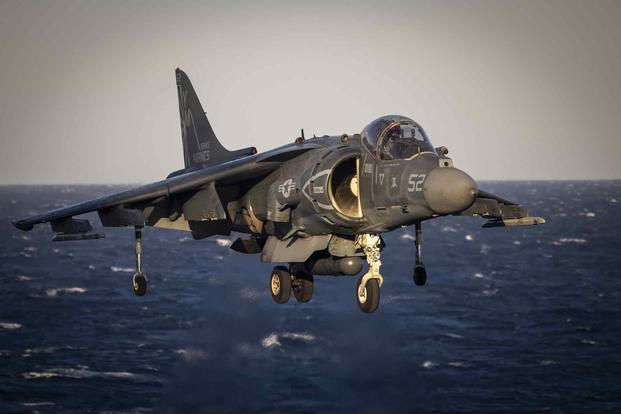

The Marine Corps AV-8B Harrier is in the twilight zone.
Earlier this year, Harriers were flying around the eastern Mediterranean on a deterrence mission amid the Israel war. The aircraft was proving its worth once again, as it has for more than 40 years.
But some of the jets are already being repurposed to museums as the Harrier — once the bleeding edge of Marine Corps aviation with its vertical takeoff and landing capability — is set to be retired and the service transitions to the new F-35 Lightning II. Its squadrons have dwindled to two, and its maintainers have hit the fleet for the last time.
“We’re in an interesting place in our history,” Lt. Col. John Cumbie, the commanding officer of Marine Attack Squadron 223, one of the remaining Harrier units out of Marine Corps Air Station Cherry Point, North Carolina, told Military.com in a recent interview.
“It is interesting to look at what we’re doing real-world operationally and also how we are divesting of our equipment, aircraft and transitioning our people to new platforms or new [military occupational specialties] in the Marine Corps,” he said.
Part of the transition plan for the Harrier, which is expected to “sunset” completely within the next three years, includes finding spots for the Marines and support personnel who use it, maintain it and help it fly.
“Harrier pilots … the maintainers, the support Marines, our Navy corpsmen and flight surgeons, it is our responsibility as the leadership to make sure that all these service members are taken care of,” Cumbie said of the likely “name-by-name” transition plan for those personnel.
That transition plan began a decade ago. Harrier officer requirements — typically pilots — have “progressively reduced” since 2014, Maj. Melissa Spencer, a spokesperson for Manpower and Reserve Affairs, told Military.com via email Tuesday. Many Harrier pilots have been or will transfer to train on the F-35.
“There is not a specific quota or goal for how many Harrier pilots will transition to the F-35. Every Harrier pilot who transitions to the F-35 brings a wealth of experience — both in the aircraft and in leading Marines — which significantly helps to fill senior leadership roles within the F-35 community,” Spencer said. “It is important that we retain their expertise, experience and talent.”
For the upcoming fiscal year, Harrier pilots were selected to fill more than 60% of the transition selections for the new aircraft, Spencer said, meaning that the new F-35 will receive a hearty number of Harrier pilots and their skills. This year marks the final year for training new Harrier pilots out of flight school and, as those final pilots hit the fleet, they will have the opportunity to go over to the F-35.
On the enlisted side, for maintainers and other crew, “planners are focused on maintaining the population of highly trained and skilled AV-8B maintenance Marines necessary to fully support the two remaining AV-8B squadrons,” Spencer said.
“There are currently reenlistment incentives to keep the appropriate number of Marines in the Harrier community,” she added, but did not specify what those incentives are or how many Marines the service expects to keep on the non-pilot side.
If eligible, Marines can transfer to communities outside of the F-35, however. Spencer specifically mentioned “future careers in areas such as communications, contracting, intelligence, logistics and other fields.”
“To support flight operations through sundown and meet F-35 support, Enlisted Assignments has a phasing plan in place to transition Marines to the F-35 community as their skills become no longer required in the Harrier community,” Spencer said. Pilots who do not transition to the F-35 — if they choose to stay in the Marine Corps — can expect to take roles as air officers supporting ground units, forward air controllers, planners or instructors, as well as other leadership or staff roles.
With the transition to the F-35, the Marine Corps is hoping to tap into the talent of the Harrier community for the new generation of jets.
“There’s a plan in place, and it’s years in advance,” Cumbie said of the scheme to help retain that community. “So, we’ve got a solid framework for how we are going to transition the right way from AV-8B Harrier to F-35.”
‘Far-Reaching Effect on Military Aviation’
The idea for an American vertical/short takeoff and landing aircraft, or V/STOL, was born in the wake of the Korean War, Larry Burke, the aviation curator for the National Museum of the Marine Corps, told Military.com in an interview.
Gen. Randolph Pate, the 21st commandant of the Marine Corps, sent a letter to the Navy in 1957 essentially saying that vertical takeoff and landing would be “an ultimate requirement for future amphibious operations,” Burke said.
Coming off of intense amphibious operations in World War II, and seeing the necessity of helicopters during the Korean War, the Marine Corps and its leaders wanted an aircraft that could bring the maneuverability of tiltrotor aircraft but with the distance and ordnance packages of a fixed-wing plane.
Marine Maj. Gen. Homer S. Hill told Congress in 1970 that “an aircraft which is deployed and based as simply as a helicopter, but which packs the punch of a conventional attack aircraft, is going to have a far-reaching effect on military aviation,” according to the National Naval Aviation Museum.
The Marine Corps had actually sent two pilots — Col. Tom Miller and Lt. Col. Bud Baker — over to the United Kingdom “on the sly” in the late sixties to test the Harrier, Burke said. The Harrier originated in the U.K., and there was institutional hesitance to use or buy foreign-made aircraft, even if it was from an ally.
“They don’t tell the Navy that they’re going over to do this,” Burke said. “And they negotiate with the British who said, ‘Your two pilots can come over, but we don’t want them wearing uniforms, and we don’t want news coverage of this.'”
Miller and Baker were “blown away” by the Harrier’s capabilities and immediately started lobbying for it within the Marine Corps, Burke said. The first deliveries of the British-built Royal Air Force version of the aircraft — with American systems attached — began in 1971.
The Harrier was integral to the Marine Corps’ amphibious operations from its outset, Burke said. Departing from ships, Marines would be able to take unimproved airfields for the Harriers to operate out of.
Using their vertical and short takeoff capabilities, the Harriers — with 22,000 pounds of thrust — could quickly launch from ships and then transition to airfields ashore, where crews and maintenance personnel could keep them flying as close to the fight as possible, freeing up amphibious ships to go elsewhere and allowing ground commanders to work directly with pilots for their operational needs.
“The idea [was] keeping the air support as close as possible to the front lines to reduce that time between the call for air support and the delivery of air support,” Burke said. “They don’t have to fly all the way back out to a carrier like the fixed-wing support; they don’t have to fly off to a friendly airfield somewhere else. That really becomes central to the idea of how the Marines planned to use, and ultimately do use, the Harrier.”
One of the best examples of the Harrier’s utility was Operation Desert Storm. According to the National Naval Aviation Museum, 86 Harriers flew combat missions from ships and the shore, and during 3,380 sorties dropped nearly 6 million pounds of ordnance against Iraq.
“Marines and the 82nd Airborne are the first U.S. units to show up in Saudi Arabia,” Burke said. “Once it’s decided that the U.S. is going to help defend Saudi Arabia against the Iraqis, Harriers are one of the first squadrons to get there.”
By the time the Global War on Terror began, the Harrier was already seeing improvements in its systems and how much ordnance it could carry, continuing to make it a necessity for Marines on the ground.
Those improvements to night vision, infrared and targeting systems — even the ability for a service member on the ground to punch in coordinates for a target that the Harrier pilot would then immediately receive — turned “what had been a day attack aircraft into a night, all-weather attack aircraft,” Burke said. In its current iteration, the AV-8B Harrier II, the aircraft has the ability to drop 500- and 1,000-pound Joint Direct Attack Munitions, or JDAMs, rockets and fire a 25mm cannon, making it one of the most lethal strike jets in recent history.
“Since then, we’re constantly upgrading and improving this aircraft through our program office and our operational test squadrons,” said Cumbie, the Harrier pilot. “And even to this day, we’re still making improvements now that will see us through the end of the life cycle of the aircraft.”
Bittersweet goodbye, but in the right direction
Cumbie, who has been part of the Harrier community for about 14 years, flew one of his squadron’s jets to the Hickory Aviation Museum in North Carolina last month, delivering it to its final stop on a 30-year road, according to the aircraft’s historical records, which were provided to Military.com by the squadron.
An estimated 3,000 spectators came to witness Cumbie perform three fly-bys alongside another Harrier on its way to the museum, according to the museum’s website.
“Rather than let this aircraft sit in a warehouse and collect spiderwebs, let’s give it to somebody who’s going to preserve it, maintain it, and keep it looking nice. and tell the story of our aircraft and our squadron and our legacy,” Cumbie said.
While the short flight was part of a long goodbye for the aircraft, it is still being used by Marines today, with six to 12 of them supporting Marine expeditionary units deployed globally, according to the Marine Corps’ 2022 Aviation Plan, though as it transitions that number may be lower.
As late as April, Harriers were embarked with the 24th MEU, according to public photos, on pre-deployment exercises in the Atlantic. The MEU, as part of the Wasp Amphibious Ready Group, or ARG, is currently in the eastern Mediterranean to deter broader regional conflict in the wake of the Israel-Hamas war, Military.com previously reported.
According to the aviation plan, the Harrier will continue to remain in operation until 2027. It is being replaced by the F-35 Lightning II, a fifth-generation fighter jet that also has V/STOL capabilities.
“Flying a tactical aircraft, there’s a lot of checklists, there’s a lot of things you’re doing throughout the flight, even if it’s just a[n] administrative flight to another airport,” Cumbie said of the aircraft’s final flight to the Hickory Aviation Museum.
“And then once you shut it down, though, and you’re shaking hands with the mayor and talking to all the folks that have come in from Charlotte and all over North Carolina, and the town there, it did start to sink in,” he said, noting that the personal feeling was “bittersweet.”
But ultimately, “from a service-level perspective, I think we’re right where we need to be,” he said.
Related: As the Marine Corps Says Goodbye to Decades-Old Jet, Its Maintainers Hit the Fleet for the Last Time
